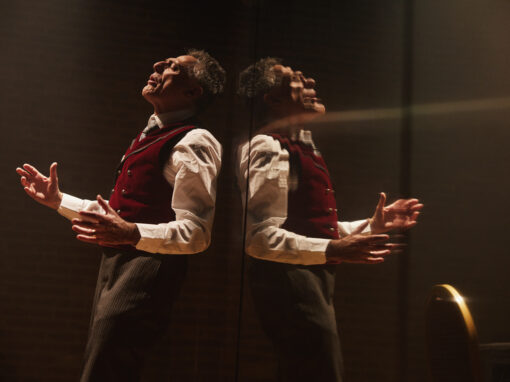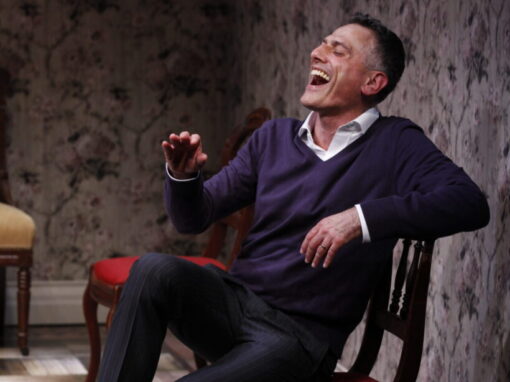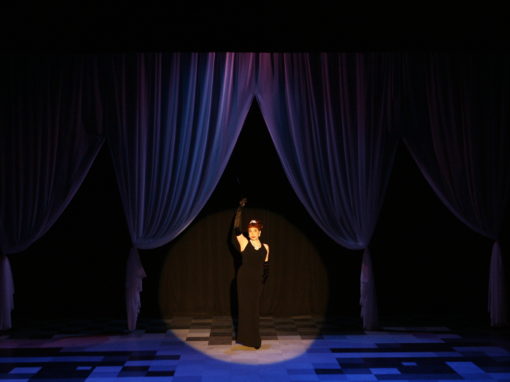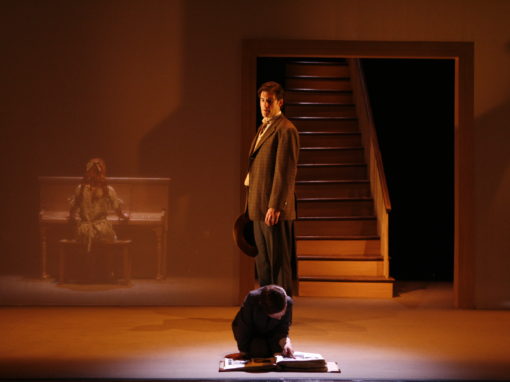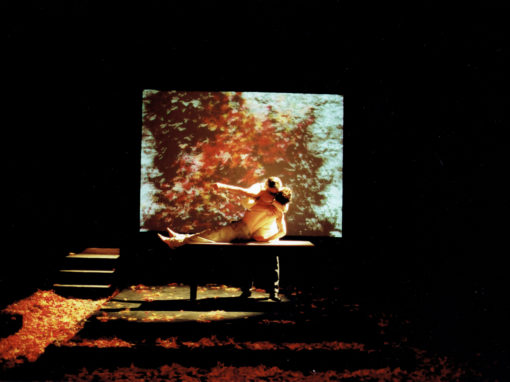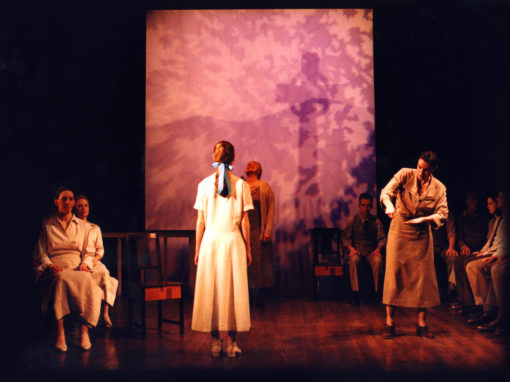My Kingdom for a Harp // by Matt Castle & Frank Galgano
Orchestrators Matt Castle & Frank Galgano take on a Golden Age Score with an Off-Broadway budget, and magic ensues.
Director Jack Cummings III has a THING about the harp. Maybe a harp once rescued him from a burning building, or he was raised by a pack of harps in the woods. We don’t know the back story, but we do have direct personal experience with Jack and his harp fixation.
For us, it all started in June 2013, when Jack called on us to help organize a Transport Group benefit concert staging of the classic musical, Once Upon a Mattress. Our job was to make the music happen: rehearse the singers, hire orchestral musicians, and conduct the performance.
We got our hands on the original 1959 orchestra books (sheet music for each individual player), studied them, did some very gentle editing, and more or less reproduced the orchestral sound of that original production—fewer brass instruments, and only four strings, with Matt at the piano to compensate for any missing notes or textures.
There was a harp in that orchestra. And it really is a special, delightful instrument! The harp part was played by our friend Lynette Wardle who, a few years earlier, had given us a lesson on how to write good harp parts. Did you know that harpists don’t use their pinkies to pluck the strings? We got the full skinny from Lynette.
We should mention that we both love Once Upon a Mattress and it has a special place in each of our hearts. When Frank was young, he directed a production (starring his sister!); and he worked on another production in which he and his best friend were dance partners in “The Spanish Panic.” When Matt was a sophomore in college, his first-ever job as a musical director was for a high school production of… you guessed it, Once Upon a Mattress.
Well, that 2013 TG Mattress concert was great fun to do. Matt conducted the orchestra, which was basically a bunch of our friends who were happy to get together on a Monday evening and play a delightful score for a good cause. Frank helped coach the vocal ensemble and sang with them in the performance.
We do lots of these concerts, and ya’ know, there’s always this feeling like, “This is so special—I wish we could do this eight times a week, then transfer to Broadway and run for years!” ‘Cause you do a ton of work and it’s a wonderful, festive night, and you want to share it with more people. But for every 50 times you do a concert and have that feeling, it actually HAPPENS like 0.035 times.
Mary Rodgers (the show’s composer) was the guest of honor at that 2013 concert. Mary was a magnificent human being. Witty, warm, brilliantly talented. And the woman had excellent taste. So, we were extremely flattered when she complimented our musical work with the orchestra and singers. And we were ecstatic when Jack reported to us that Mary was also having that “let’s do this eight times a week” feeling. She kept having that feeling, and for months after the concert she continually poked Jack, asking when Mattress would get its full production. In the spring of 2015, Jack told us this had been going on, and that TG was ready to start making firm plans. Would we like to serve as musical directors, and create new arrangements and orchestrations? Yes yes yes.
Our first question: What’s wrong with the original orchestration? Answer: Nothing, it is perfect! Hershy Kay’s scoring is as witty, warm, and brilliant as Mary’s music and Marshall Barer’s lyrics.
Still… Something about using the original instrumentation didn’t quite feel right for our project. For one thing, it required too many players (20) for our Off-Broadway budget. So, at the very least, we’d need to do some pruning. We could cut the harp, but then we’d be ruining Jack’s life.
Okay, so we were looking at re-orchestrating the score for an affordably small ensemble. Which must include a harp. To be clear: we put up no fight. We love the harp. But what additional instruments did we need?
To gain some clarity, we reset the conversation and started from zero: What did we want our show to be, and what elements did we have as givens?
Element one was the script and score. Gently subversive and deceptively sophisticated, Once Upon a Mattress is a cheeky re-telling of the Hans Christian Andersen fairy tale, The Princess and the Pea. The show is elegantly constructed using archetypal characters and situations. The dialogue wryly juxtaposes the medieval and the modern, so you’re hearing words like “moat” and “hey nonny” uttered in what is basically a vaudevillian olio, or a sitcom setup. Similarly, the music blends Renaissance polyphony and modal harmonies with swing rhythms and jazz-age song forms. Our musical arrangements should celebrate the jangling wackiness of these disparate elements in such a way that our audience, historically overexposed to style mash-ups, can appreciate the freshness and cleverness of what the authors created. And our orchestra should be flexible enough to sound like a Renaissance consort in one moment, a swing band in the next.
Element two was the cast. Our headliners, Jackie Hoffman and John “Lypsinka” Epperson, were set to reprise their 2013 concert roles as Princess Winnifred and Queen Aggravain. Talk about gently subversive and deceptively sophisticated. We conversed with Jack about his vision for the show; he wanted it to feel like Fractured Fairy Tales, the famous cartoons from The Rocky and Bullwinkle Show which ran on television in the early 1960s—a reference that made immediate sense to us. He wanted the rest of the principals to be charismatic and golden voiced, like you’d expect to find in a classic musical. And he wanted the chorus to be quirky and varied, an “Island of Misfit Toys” (another television reference we understood instantly). So, our orchestrations needed to be flexible enough to make a blended, lush sound appropriate for a love ballad, but contain lots of vivid individual sounds for maximum quirk potential.
We were creating a set of creative boxes that needed to be ticked. This is how we often start our creative process. And throughout the process, we were continually grateful for the privilege. It was our special joy to immerse ourselves in the zany, colorful world of the show, to deconstruct and study Mary & Marshall’s songs, to discover treasures of counterpoint, internal rhyme, character portraiture—the stuff that music nerds live for. The more we dug into the material, exploring it with Jack, choreographer Scott Rink, set designer Sandra Goldmark, illustrator Ken Fallin, costume designer Kathryn Rohe, lighting designer R. Lee Kennedy, and sound designer Walter Trarbach—the more we found to admire in the show’s writing.
But what about the orchestra? We knew all the things we wanted the orchestra to be able to do and sound like. But we needed to think carefully about the number of players. This is Off-Broadway, where every dollar gets stretched to the max. We could probably afford like 4 or 5 players. Okay. So, we started imagining groupings of instruments, for instance: Harp, Piano, Drums, 1 Trumpet, and 1 Reed player (alternating on various instruments like Flute, Clarinet, and Tenor Sax).
Hmmm… Swing music with no Bass? That didn’t seem right. Also, the Trumpet would be sitting around a lot during songs like “The Swamps of Home.” Kind of a waste to hire five musicians and leave one sitting around. Also, we’d all fallen in love with the sound of our string players in the 2013 concert. Surely, we couldn’t do without any strings?
How about this one: Harp, Drums, Bass, Violin, and 1 Reed player.
Ugh. Swing music with one Sax and no Brass. And how exactly is the Violin contributing to the big numbers like “Opening for a Princess” and “Shy”? This was basically the inverse of the problem we had with the first ensemble.
Okay let’s try: Harp, Bass, Violin, Trumpet, Trombone.
Are you kidding me?
Et cetera.
This happens A LOT. “We want it to sound amazing. You get five instruments.”
We were banging our collective heads on the wall, trying to devise a five-player ensemble that would tick all the creative boxes. And satisfy you-know-who’s harp obsession.
Finally, we had to break the news that we could do it with five players ONLY if we didn’t use the harp. Deadly silence on the phone. Actually, the silence was not so much deadly as dejected. The silence of quashed dreams. At the end of the silence, Jack asked us: “How many players would there need to be to make it sound right and get me my harp? I really need it.” We said it would take a lot more instruments, like ten or twelve. “Hmmm,” said Jack. He said he needed to think.
A few days later, he called back to say he’d shaken out the couch cushions and found some extra cash. We could have twelve players. TWELVE! For an Off-Broadway show! Unheard of.
We cannot stress enough that this NEVER happens. “We want it to sound amazing. What do you need? Here, have ALL the instruments.”
We didn’t ask Jack if he was serious, we just hung up fast and started orchestrating before he had a chance to take it back.
With twelve players, it felt like an ORCHESTRA. Not a piano with a few additional helpers, but an Orchestra. In fact, when he gave us that wonderful, glorious number—we’ll repeat it because it feels so good, TWELVE—our first decision was to cut the Piano from the pit. When there’s a Piano, it tends to function as the musical bedrock of the ensemble. It chugs along keeping the rhythmic motor steady, and it outlines the harmonies, so your ear can follow the chord progressions clearly. You lay down a piano player and build everything else around/atop that foundation. Wind and string instruments must tune to the piano, instead of tuning to each other. Even if your ear doesn’t consciously detect the sound of the piano, that instrument dominates the musical texture.
So, we made a gutsy decision. Since our show’s fictional kingdom was populated by a diverse hodgepodge of misfit toys, then our orchestra should be just as individuated, just as much of a chamber ensemble, with everyone’s participation equally necessary for the whole thing to work. We could do without the lynchpin of the Piano.
This plan was not without its risks. Two days before our first preview, there were scenic transitions still unwritten, and there was no piano in the building (we’d had it moved out of the pit to make room for all those players we hired!). The orchestra, gifted as they were, could not spontaneously improvise a 20-second madrigal based on “In a Little While.” So, we resorted to Plan B, which was Matt singing loudly from the pit while the actors moved the scenery and the orchestra sat dumbfounded.
Speaking of scenery, Sandra Goldmark’s set design was a riff on Jack’s Fractured Fairy Tale notion: She created an assortment of set pieces that could be reconfigured to suggest various locations around the castle, while Ken Fallin literally sketched in a backdrop for each scene. So, the action was divided into panels, like a cartoon or comic strip—but within this cartoonish device, you’re being treated to an act of spontaneous live creativity by a master artist. Such a witty design.
So those scene changes. Yeah, each scenic shift was a theatrical event in its own right. And each one required tailored musical accompaniment. We ended up creating a progression of vocal miniatures, mini-madrigals based on melodies from the score. Scott would stage the actors to come out and change the scenery in little groups of three, four, five people, and they’d sing a chorus of “She’s always been shy, tra la la…” We got to feature our outstanding ensemble, and we got to expand the world of the show. Scene changes are generally the last thing composed/arranged/orchestrated; hence Matt Castle bellowing a cappella from the pit two days before previews. But of course, completing those final touches was only a few gallons of midnight oil away.
Once the whole production was put together, we were very proud of the result. The sound of the orchestra was thrilling. After weeks of painstaking, solitary work, of feeble attempts to describe “what it will sound like when the band plays it,” we all gathered at Carroll Music one morning, and everyone finally got to hear it. There’s nothing like people making music together. We will always cherish our memories of that first orchestra read, with Jack, Scott, Hannah Oren (TG Artistic Producer), us two, and a dozen superb musicians, all teary-eyed because we were hearing this special score lovingly played by our beautiful chamber ensemble. The wonderful Mary Rodgers was no longer with us, but if there’s a Heaven, we hope she has a great place there, and that maybe she listened in on our orchestra read, and that it made her smile.
Those twelve players were:
Dustyn Richardson – Recorder, Piccolo, Flute, Alto Sax
Michael Favreau – Clarinet, English Horn, Tenor Sax, Baritone Sax
Les Rogers – Trumpet
Jason Wiseman – Trumpet
Debbie Schmidt – Horn
Chris Rinaman – Trombone
Jonathan Linden – Guitar
Michael Blancaflor – Percussion
Jordan Tarantino – Violin
Ro Rowan – Cello
Jeffrey Levine – Bass
And of course, Kathryn Sloat playing…
The harp.
About the author:
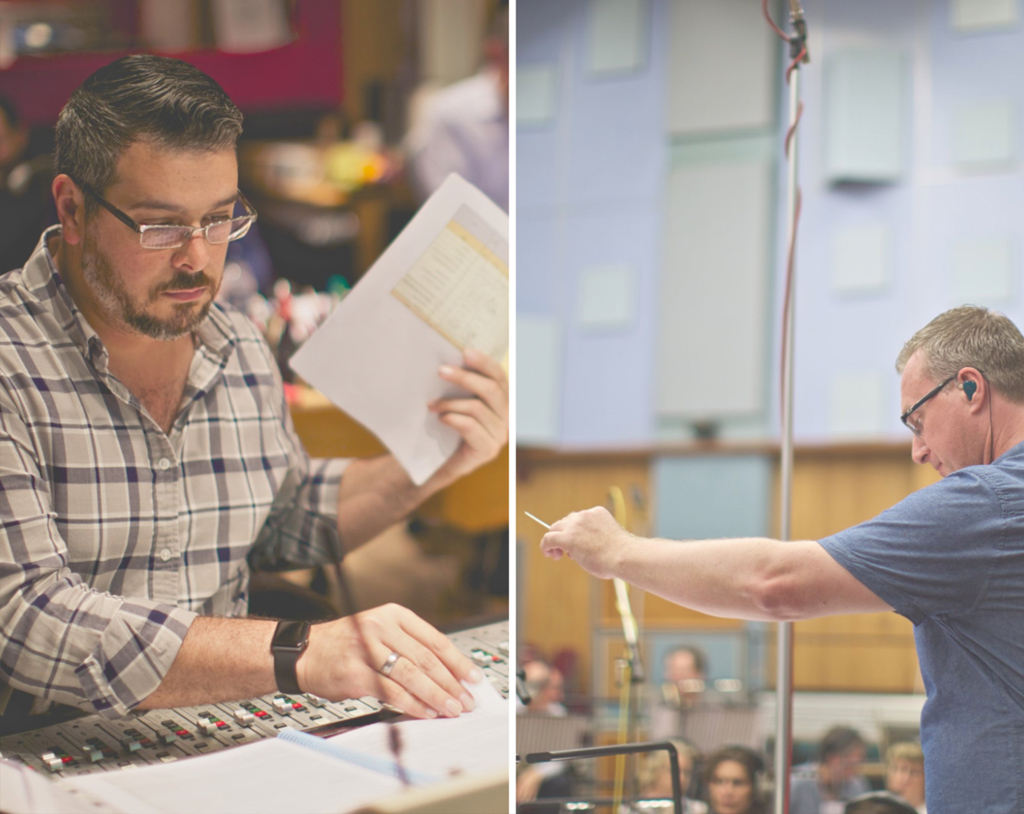
Explore Our Past Shows
